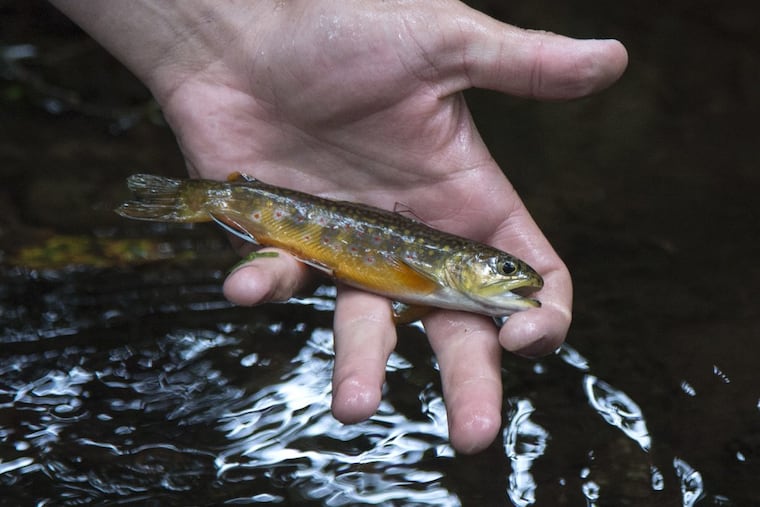Environmentalists fear Trump water rule could impact Delaware, other area rivers
A Trump administration effort to remove some bodies of water from federal oversight has environmentalists worried about protecting the nation's water supply.

First came rollbacks of air and fuel emissions rules.
Now, the Trump administration has proposed a rule it says will boost economic growth by removing confusion about which waterways can be regulated. Environmentalists and conservationists, however, contend the plan will mean open season on developing land that should be regulated to avoid contaminating water, potentially allowing even pipeline development on sensitive properties.
They fear it even could weaken protections around the headwaters of the Delaware River.
Andrew Wheeler, acting administrator of the Environmental Protection Agency, said the new rule calls for six categories of water sources that should allow property owners to determine whether water on their land would be federally regulated without the need to hire costly engineers. He said the Obama administration’s 2015 rule that the Trump administration wants to replace was about grabbing more federal power, not protecting water quality.
Wheeler said 22 states operate under the 2015 Waters of the United States rule, while 28 follow a rule from 1986 because of lawsuits. That has created confusion, Wheeler said, and hindered economic development. The rule determines which water sources are covered under the Clean Water Act.
Wheeler said his proposal is “in the national interest to ensure that the nation’s navigable waters are kept free from pollution, while at the same time promoting economic growth, minimizing regulatory uncertainty, and showing due regard for the roles of Congress and the states under the Constitution.”
Environmentalists say the new federal rule will exempt critical areas from regulation, such as streams and tributaries that don’t run year-round, and wetlands not directly connected to larger bodies of water. Yet water from these areas ends up in the public water supply, and the lands also act as filters for pollution, they say.
“Trump’s rollback of the Waters of the United States Rule will make it easier for developers, miners, and big business to pollute our rivers and streams,” said Jeff Tittel, director of the New Jersey Sierra Club. "Trump’s rollback is his war on the environment and attack on clean water. These are called WOTUS because they belong to all of us. They do not belong to developers, agribusiness, or polluters. "
The Waters Advocacy Coalition, an advocacy group for farmers and ranchers, hailed it as a step to provide “regulatory clarity” in the face of “onerous, overreaching federal regulation.”
Though Wheeler said much of the 2015 rule designating various types of waterways will remain intact, parts of it will change. And that’s what has drawn the ire of environmental groups.
Disputes between those that want more water sources included in federal regulations and those that don’t are framed in a 2006 Supreme Court decision, in which Justice Anthony M. Kennedy wrote that waterways with a “significant nexus” to navigable waterways should be regulated. However, Justice Antonin Scalia wrote that only “relatively permanent” waterways should be covered.
The new rule, which has to undergo a 60-day public comment period before final adoption, calls for six categories of water sources to be regulated: traditional navigable waterways such as oceans, big rivers and lakes; tributaries such as rivers and streams that feed into traditional navigable waters such as the Delaware River; ditches, such as the Erie Canal; certain lakes and ponds, including those that contribute flow to traditional navigable waterways; reservoirs and adjacent wetlands that normally connect to larger bodies of water, and intermittent or perennial areas that provide a significant amount of water in a given year based on 30 years of rainfall data.
Some water sources, such as groundwater, wastewater treatment systems, and detention ponds, are already exempt. But some of the 11 proposed exemptions remain controversial, including carve-outs for isolated wetlands not directly connected to a bigger water source by land, and ephemeral sources that contain water only during rainfall. Ephemeral sources are prevalent in the West but also are significant locally.
However, the EPA has no comprehensive map of all of the water sources in the U.S., so it’s nearly impossible to say with any precision how many of those sources will be affected by the new rule.
Environmental groups say ephemeral streams and wetlands comprise a large part of the overall water sourcing for the U.S. Though they may not be connected year-round directly by surface water, they are connected through groundwater and aquifers. So they enhance overall water quality, remove pollution, and mitigate flooding, as well as provide wildlife habitat. The environmentalists fear rolling back protections will allow pesticides, industrial waste, and other pollutants now prohibited to ultimately contaminate wetlands or streams.
States will still be able to enforce their own rules. New Jersey and Pennsylvania have stringent laws in place, but watchdogs fear a rollback of federal protections will increase confusion and result in less enforcement.
David Kinney, Eastern policy director for Trout Unlimited, called it a “fundamentally flawed step back for the Clean Water Act” because it will eliminate protection for thousands of miles of head-water streams. He said small streams that flow only briefly are just as important as larger bodies of water.
Stephanie Wein, the clean water advocate for PennEnvironment, said it’s “challenging" to know immediately which specific headwaters of the Delaware River would be impacted. But, she said, the water sources that supply the river come in all forms: wetlands, ephemeral streams, and intermittent streams.
“Given that the watersheds in the region include the type of waterways that would be excluded by the proposed rule, we know there will be an impact on the Delaware,” Wein said.